Non Verbal Reasoning Grouping of Identical Figures Questions - 1
Question: 1
In each of the following questions, group the given figures into three classes using each figure only once.
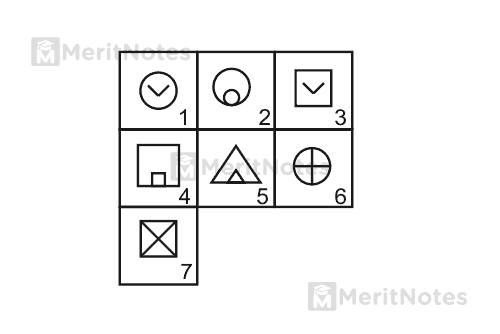
(A) 1, 3; 2, 4, 5; 6, 7
(B) 1, 2, 6, 7; 3; 4, 5
(C) 1, 3; 2, 6; 4, 5, 7
(D) 1, 2, 6; 3, 4, 7; 5
Ans: A
1, 3 contain a V-shaded element inside a geometrical figure.
2, 4, 5 contain two similar elements, one placed inside the other and touching it.
6, 7 contain geometrical figures which are divided into four equal parts by two mutually perpendicular straight lines.
Question: 2
In each of the following questions, group the given figures into three classes using each figure only once.
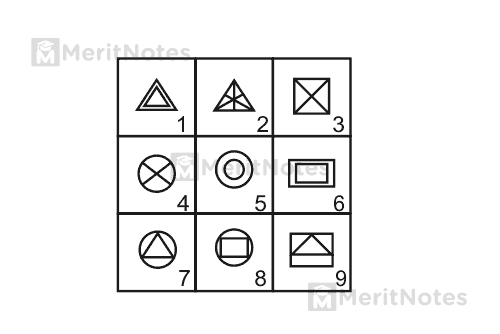
(A) 1, 4, 7; 2, 5, 8; 3, 6, 9
(B) 1, 3, 5; 2, 4, 8; 6, 7, 9
(C) 1, 2, 3; 4, 5, 8; 6, 7, 9
(D) 1, 5, 6; 2, 3, 4; 7, 8, 9
Ans: D
1, 5, 6 have two similar elements, one inside the other.
2, 3, 4 contain straight lines each dividing the figure into two equal parts.
7, 8, 9 have one element placed inside a different element.
Question: 3
In each of the following questions, group the given figures into three classes using each figure only once.
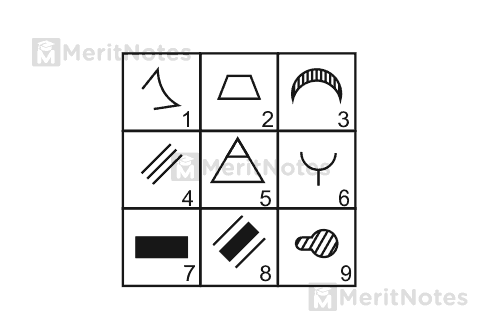
(A) 1, 3, 6; 4, 5, 8; 2, 7, 9
(B) 2, 3, 9; 4, 5, 8; 1, 6, 7
(C) 3, 8, 9; 1, 2, 7; 4, 5, 6
(D) 1, 6, 8; 3, 7, 9; 2, 4, 5
Ans; D
1, 6, 8 are figures composed of straight as well as curved lines.
3, 7, 9 are closed figures shaded by oblique line segments.
2, 4, 5 are figures composed of straight lines only.
Question: 4
In each of the following questions, group the given figures into three classes using each figure only once.
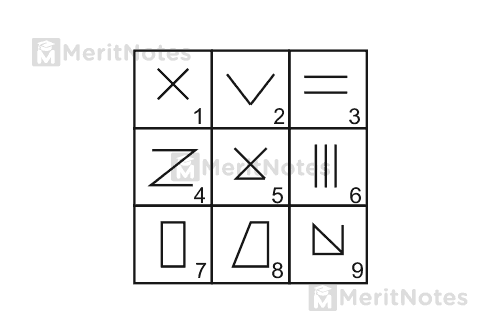
(A) 1, 9, 7; 2, 8, 5; 3, 4, 6
(B) 1, 5, 9; 3, 6, 2; 4, 7, 8
(C) 1, 3, 5; 2, 4, 6; 7, 8, 9
(D) 1, 2, 3; 4, 5, 6; 7, 8, 9
Ans: D
1, 2, 3 are figures composed of two straight lines.
4, 5, 6 are figures composed of three straight lines.
7, 8, 9 are figures composed of four straight lines.
Question: 5
In each of the following questions, group the given figures into three classes using each figure only once.
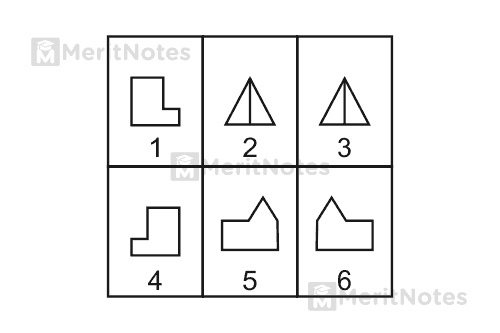
(A) 1, 4, 2, 3, 5, 6
(B) 1, 5, 2, 6, 4, 3
(C) 1, 6, 2, 3, 4, 5
(D) 1, 4, 2, 3, 5, 6
Ans: D
(1, 4) (2, 3) and (5, 6) are three different pairs of identical figures.
Signals and Systems Quiz Questions and Answers Pdf More
Signals and Systems MCQ Questions and Answers Pdf More
Electrical Power Sources Quiz Questions & Answers Pdf More
Electromagnetic Field Theory Question Bank 2024-2025 More
Power Semiconductor Device and Integrated Circuits Questions More
Top 1000+ Computer Fundamentals Questions and answers More
1000+ Electrical Machines Quiz Questions and Answers Pdf More
1000+ SBI Computer Question Paper with Answers Pdf More
1000+ Aptitude Test Questions and Answers Pdf More
1000+ Software Testing Interview Questions and Answers Pdf More